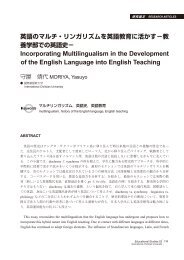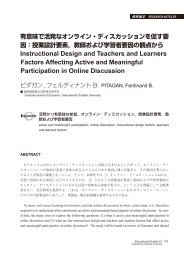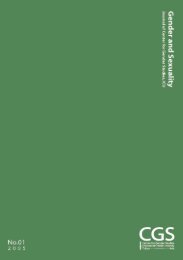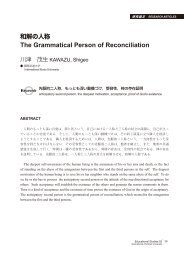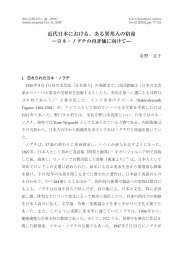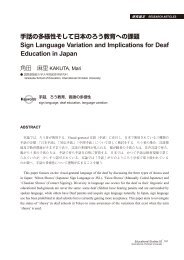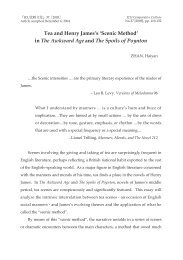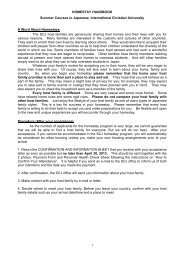Colonial Adaptations in Tropical Asia: Spanish Medicine ... - icu.ac.jp
Colonial Adaptations in Tropical Asia: Spanish Medicine ... - icu.ac.jp
Colonial Adaptations in Tropical Asia: Spanish Medicine ... - icu.ac.jp
You also want an ePaper? Increase the reach of your titles
YUMPU automatically turns print PDFs into web optimized ePapers that Google loves.
the result of pacts with the devil. 32) Nonetheless, it is the same Father Alc<strong>in</strong>a, S.J.<br />
(1669) who forged a friendly relationship and understand<strong>in</strong>g with the local herbalists<br />
to study the medic<strong>in</strong>al qualities of various plants <strong>in</strong> the Samar and Leyte islands. 33)<br />
In at least three chapters of his book on the history of the Visayan peoples, he was<br />
able to identify and characterise the therapeutic as well as the poisonous qualities of<br />
trees and plants. From this account, the methods and sources of the religious’ studies<br />
of the medic<strong>in</strong>al qualities of various plants become clear. The friars did not necessarily<br />
supplant the curandero, but rather secularised their heal<strong>in</strong>g arts for these to<br />
become palatable to the ecclesiastical authorities and thereby proceed unquestionably,<br />
with the motive of fill<strong>in</strong>g <strong>in</strong> the gap made by the lack of medical professionals<br />
and supplies. Jose P. Bantug (1951) and Sixto de los Angeles (1935) identify this period<br />
<strong>in</strong> the development of local <strong>in</strong>digenous medic<strong>in</strong>e as the “empiric period” with the<br />
evolution from the mythical and supernatural aspect of heal<strong>in</strong>g. 34)<br />
Botany and Herbal Medic<strong>in</strong>e<br />
The most accepted aspect of traditional <strong>in</strong>digenous heal<strong>in</strong>g arts was herbal therapy<br />
or opotherapy. From this, the padres explored the tropical botanical landscape.<br />
The first recorded missionary to identify and record the medic<strong>in</strong>al qualities of plants<br />
was Fr. Blas de la Madre de Dios, O.F.M., who <strong>in</strong> 1611, recorded them <strong>in</strong> his Flora de<br />
Filip<strong>in</strong>as [Philipp<strong>in</strong>e Plants] and later Tratado de Medic<strong>in</strong>a Domestica [Treatise on Domestic<br />
Medic<strong>in</strong>e], based on his studies and works <strong>in</strong> Cagayan. 35) Given the Franciscans’<br />
preponderant aff<strong>in</strong>ity towards health care, Father De la Madre de Dios,<br />
O.F.M.’s pioneer<strong>in</strong>g <strong>in</strong>itiative served as a guide post for other religious orders also<br />
work<strong>in</strong>g to catalogue the medic<strong>in</strong>al properties of various plants and m<strong>in</strong>erals. Fr.<br />
Jose de Valencia, O.F.M. followed up from the work of Father De la Madre de Dios,<br />
O.F.M. along similar botanical l<strong>in</strong>es. 36)<br />
From this po<strong>in</strong>t, the friars’ works of study<strong>in</strong>g and compil<strong>in</strong>g the botanical and<br />
pharmaceutical properties of herbal plants blurred the dist<strong>in</strong>ction between the sciences<br />
of botany, pharmacology, and medic<strong>in</strong>e. The friars, primarily serv<strong>in</strong>g as spiritual<br />
m<strong>in</strong>isters also became doctors of the body as the priest-botanists also doubled<br />
as physician-pharmacists and at times surgeons. Such a reality existed <strong>in</strong> far-flung<br />
rural areas where afflicted patients had no access to <strong>Spanish</strong> medic<strong>in</strong>e, and most<br />
likely, discredited the efficacy of the local curandero or mediquillo. A Recollect priest,<br />
Fr. Miguel Aganduru, tried to answer the call of charity as early as the 1620s by<br />
writ<strong>in</strong>g the 142-page Manual de Medic<strong>in</strong>as Caseras para Consuelo de los Pobres Indios<br />
[Medical Manual to aid the Poor Indians] with the <strong>in</strong>tention of help<strong>in</strong>g ill patients,<br />
ord<strong>in</strong>ary Filip<strong>in</strong>os (assum<strong>in</strong>g they could read <strong>Spanish</strong>) who could not afford <strong>Spanish</strong><br />
medic<strong>in</strong>e. 37) In most cases though, priests-botanists-physicians were orig<strong>in</strong>ally untra<strong>in</strong>ed<br />
<strong>in</strong> the natural sciences, but their conviction to aid those <strong>in</strong> need is already a<br />
testament to their accomplishments. 38)<br />
However, not all of the missionary friars assigned to the Philipp<strong>in</strong>es were orig<strong>in</strong>ally<br />
untra<strong>in</strong>ed <strong>in</strong> the natural sciences. Bro. Georg Joseph Kamel, S.J., a Moravian<br />
Jesuit missionary sent to the Philipp<strong>in</strong>es <strong>in</strong> 1688 had a prior tra<strong>in</strong><strong>in</strong>g as an<br />
<strong>in</strong>firmarian and pharmacist <strong>in</strong> Bohemia. 39) Unlike the other European-tra<strong>in</strong>ed physicians<br />
and pharmacists sent to Manila, Brother Kamel, S.J. did not reject traditional<br />
176



